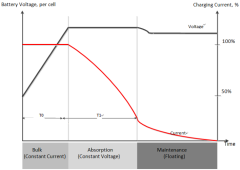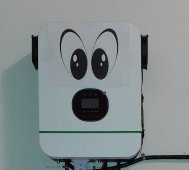I think it's fair to say that the various different lines of SPF inverters from Growatt have differing charging algorithms, so my advice below might not work for everyone.
After experiencing the same problems described by apctjb, I've done a lot of experimentation with my SPF 3500 ES and have landed on the following settings, which work very reliably:
Program 01 (Output source priority): SBU
Program 02 (Maximum charging current): 60A
Program 03 (AC input voltage range): APL
Program 04 (Power saving mode enable/disable): DIS
Program 05 (Battery type): USE
Program 06 (Auto restart when overload occurs): DIS
Program 07 (Auto restart when over temperature occurs: DIS
Program 08 (Output voltage): 230V
Program 09 (Output frequency: 50
Program 10 (Number of series batteries connected): 4
Program 11 (Maximum utility charging current): 10A
Program 12 (Setting voltage point back to utility source 44.0V~51.2V): 44V
Program 13 (Setting voltage point back to battery mode 48.0V~58.0V): 48V
Program 14 (Charger source priority): OSO
Program 15 (Alarm control): OFF
Program 16 (Backlight control): ON
Program 17 (Beeps while primary source is interrupted): OFF
Program 18 (Overload bypass): DIS
Program 19 (C.V. charging voltage): 55.0V
Program 20 (Floating charging voltage): 54.6V
Program 21 (Low DC cut-off voltage): 40.0V
Program 43 (Battery equalization): DIS
Program 44 (Battery equalization voltage): N/A
As far as I can tell, only program 02, 05, 19 and 20 have any effect on the charging algorithm, however I've included all my settings just to be complete. Obviously it's set up for my specific purposes and all these settings aren't appropriate for everyone.
Programs 19 and 20 need to be carefully tuned to your battery pack. Even 0.1v variation in these settings can make a large impact to the way your inverter operates. I'm yet to figure out all the intricacies of the algorithm (e.g. what defines the duration of the absorption and float cycles), but the most important factors are below:
- Program 05 (USE) is very important. The manual claims that US2 is for lithium batteries, however I've never seen US2 working reliably. USE works well when considering the points below.
- The charger will go through three stages: bulk (constant current - program 02), absorption (constant voltage - program 19) and float (program 20):

- The charging algorithm ceases solar input if the battery voltage remains higher than the float voltage after absorption charging is complete. Therefore, Program 19 and Program 20 (voltages for absorption and float respectively) must be close together, and must also be close to the "knee" of your battery charging curve. This is to ensure the battery voltage naturally and quickly drops to a lower level during the transition from bulk to float charging voltage. A difference between these settings of more than about 0.5v on my system will prevent solar from powering loads after charging is complete. 0.5v will float my batteries for an hour or two in the morning, then stop charging while still powering the loads from solar for the rest of the day. 0.4v will float my batteries for most of the day.
- If the above conditions are satisfied and solar input is still operating after a charging cycle completes, the charger will restart a bulk/absorption/float cycle again when the battery voltage drops 2v below Program 19. This should only occur if solar energy isn't sufficient to power your loads, or the battery has otherwise discharged a bit.
Therefore, when troubleshooting these issues, check the following:
- Make sure USE is selected for Program 05.
- Set the voltage for program 19 slightly above the knee in the charging curve of your batteries, and set program 20 about 0.5v less than program 19. Setting program 20 too low will not allow the batteries to drop their voltage far enough in the transition between absorption and float modes. 3.4375v per cell for program 19 is about as low as I've been able to reliably operate. Setting program 20 too high risks damage to your cells.
- When working with such small refinements, every battery pack will be different. Adjust in small increments until you've found your sweet spot.
Edit: I should note that my charging voltages are very conservative. Some people may choose much higher voltages, however I prefer to keep them low to reduce any chance of stressing the cells. A very high SOC can still be achieved at about 3.43v per cell with slightly more charging time, which is fine for my use case.







